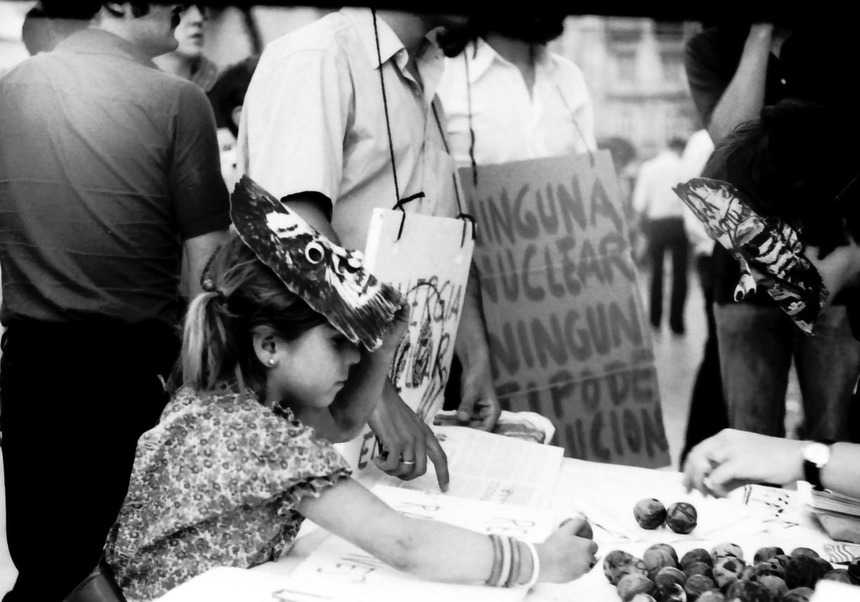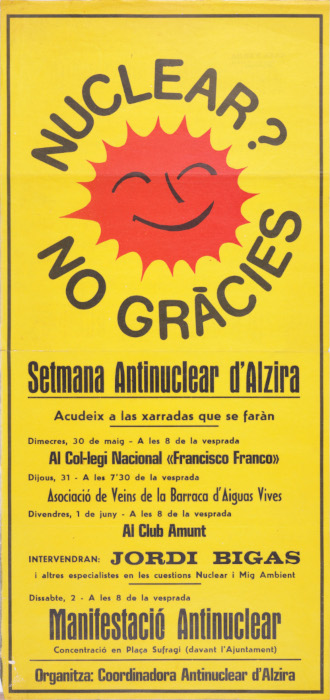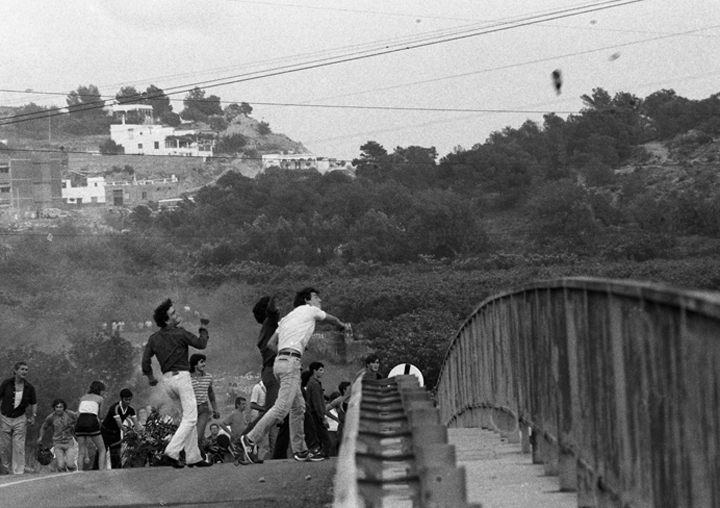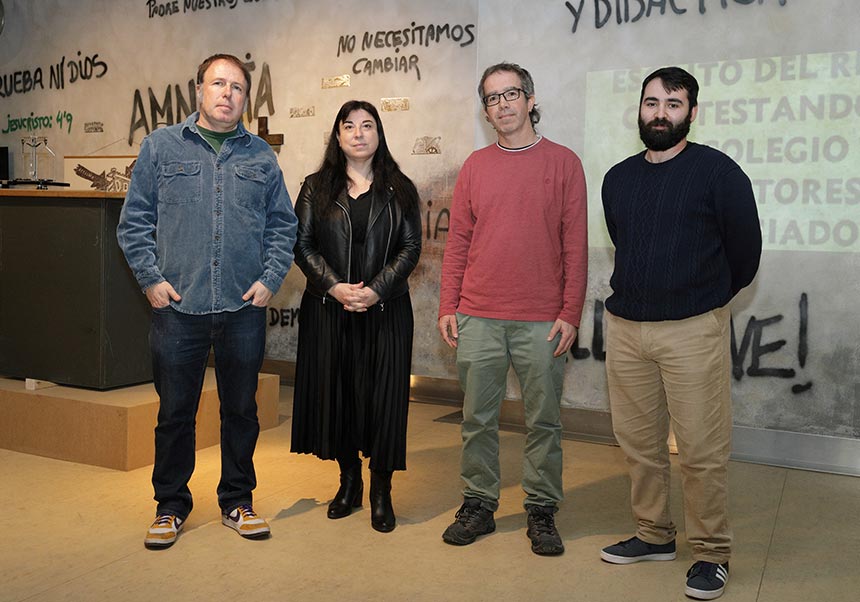The UV gives visibility to the eco-warrior battle from the 1970s to the present day at La Nau
- University Culture Service
- March 14th, 2024

The Universitat de València is showing the eco-warrior battle from the 1970s to the present day at the La Nau Cultural Centre through the exhibition ‘Eco-warrior file. Memory and visual culture of environmentalism in Valencia since the 1970s'. The opening ceremony was held on Wednesday 13 March at 20:00. Beforehand, at 18:00, and as part of the complementary activities of this exhibition and the Universitat's programme for 8M, a panel discussion took place in the Aula Magna, with women who have played a key role in the history of the Valencian eco-warrior movement.
The historical activist and professor at the Universitat de València Josep-Vicent Marqués was already clear about the fact that environmentalist memory is an element of political agency when he wrote his influential book 'Ecología y lucha de clases' (1978) in late 1970s. This exhibition, which can be visited at La Nau's Sala Oberta until 9 June, is based on Marqués' intuitions and the efforts of other fellow environmental activists of the time, such as Alejandro de la Cueva and Ferran García, promoters of the Fons de Documentació del Medi Ambient de La Casa Verda in 1982, the most extensive archive on environmental issues in Spain, whose collections were deposited in 2010 at the UV.
Curated by Alberto Berzosa, professor at the Autonomous University of Madrid, and Jaime Vindel, researcher at the CSIC, a large part of this documentary material - more than a hundred works, including documents, posters, leaflets, photographs... - are on display for the first time to the public. The material comes mainly from the Fons de Documentació del Medi Ambient de La Casa Verda in 1982, now at the Universitat, but also comes from the following lenders: El Punt. Espai de Lliure Aprenentatge, Marfull-Acció Ecologista Agró, Col-lectiu Margarida i altres herbes, AVV Barri de Sant Marcel-lí and Arxiu A Hores d'Ara and private lenders. The exhibition has the support of the European Green Capital 2024, Valencia City Council, the López Piñero Interuniversity Institute, the Vicent Peset Llorca Historical and Medical Library, the IVC Film Archive and El Punt. Espai de lliure aprenentatge.
Taking this documentary repertoire as a starting point, the exhibition proposes a journey through the audiovisual and material memory of the ecologist movement in the Valencian sphere, with a triple objective, as the curators explain. Firstly, to alleviate the scant weight of environmentalism (particularly in its visual dimension) in historical discourses on contemporary Spain, in particular those that revolve around the period of the Transition; secondly, to reread the recent history of social mobilisations in our country in the light of a selection of materials produced by activists and to add the materials of environmentalism. And finally, to review archival technologies and their material status and to propose systems for accessing these funds.
The exhibition is divided into five sections: ‘Agentes del ecologismo', ‘Nuclear? No gràcies', 'De l'Albufera a l'Horta', 'Salvem', and 'Ecologismo urbano y alternativas energéticas'.
The first section includes a map of the Valencian Community, which shows the most representative environmental groups from the 1970s to the present day and where various documentary and graphic materials on the subject are displayed. The public is also allowed to interact through the installation of 'tablets', among other devices, which give the public access to the funds on this subject present in the exhibition.
The second section, dedicated to making anti-nuclear mobilisations visible, shows a selection of posters on the subject, most of them unpublished.
 The third section focuses on the spaces in the territory that have to do with wetlands: l'Albufera and l'Horta, and how the use of water in these places has been conditioned by industrial development from the 1970s onwards. Both areas have rethought their use in relation to industrial development. This section shows materials from the campaigns for the protection of l'Albufera or the defence of l'Horta.
The third section focuses on the spaces in the territory that have to do with wetlands: l'Albufera and l'Horta, and how the use of water in these places has been conditioned by industrial development from the 1970s onwards. Both areas have rethought their use in relation to industrial development. This section shows materials from the campaigns for the protection of l'Albufera or the defence of l'Horta.
The fourth section deals with how environmentalism has permeated the social movements that inspire the defence of the territory and the protection of natural heritage, promoting ecological actions known as Salvem El Botànic, or around Ciutat Vella, which have as their background the mobilisation of grassroots citizens for ecological issues.
And the last section focuses on specific campaigns related to waste, pollution, transport and alternative energies.
In the framework of the exhibition, up to three films loaned by IVC Film Archive can be seen: 'Levante feliz? País perplex, by the Col-lectiu d'Escola Crítica, (1983), Biotopo, by Carles Mira, (1973) and Manifestació ecologista i antinuclear. In addition, up to thirty photographs of Valencian environmental activist groups from the 1970s to the present day are presented, and in the upper Senate, Defensem, the installation by the artist Anaïs Florín, which recovers multiple historical slogans of Valencian environmentalism, and which, after the closure of this exhibition, will be installed in other university spaces as part of the programme Cultura als campus (Culture on Campus).
The Universitat, also through the Office of the Vice-Principal for Culture and Society, which has organised this exhibition, has developed an ambitious programme of complementary mediation activities.
‘Nuclear? No gràcies, Coordinadora Antinuclear d’Alzira’', 1979. Fons de Documentació del Medi Ambient de La Casa Verda/ Biblioteca Historicomédica del IILP.
More information:
File in: Cultura , Exposicions , Centre Cultural La Nau















